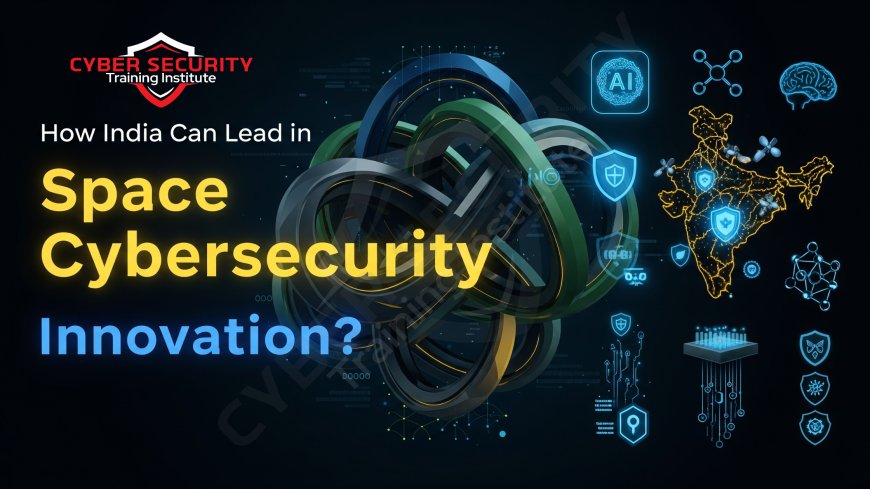How India Can Lead in Space Cybersecurity Innovation
From the triumphant landing of Chandrayaan-3 on the lunar south pole to the ambitious Gaganyaan human spaceflight mission, India's space program has captivated the world. The Indian Space Research Organisation (ISRO) has cemented its position as a global leader, celebrated for its cost-effective and highly successful missions. However, as India's space ambitions grow, so do the risks. The same satellites that provide vital communication, navigation, and defense capabilities are also becoming high-stakes targets for cyber threats. A single, well-executed cyberattack could not only cripple a mission but also compromise national security and economic stability. While India has demonstrated remarkable prowess in building and launching space assets, the next frontier is not just a physical one—it is a digital one. To secure its future in space, India must pivot from being a leader in space technology to a global leader in **space cybersecurity innovation**. This is not merely a matter of defense; it is a strategic opportunity to build a new ecosystem of technology, talent, and partnerships that can set a new standard for a secure and resilient space economy. This blog post explores the challenges and outlines a strategic roadmap for how India can seize this moment and lead the world in safeguarding the final frontier.

Table of Contents
- Introduction
- The Growing Space Cybersecurity Threat
- India's Current Space Cybersecurity Posture
- A Five-Point Roadmap to Leadership
- Why India is Uniquely Positioned to Lead
- Conclusion
- Frequently Asked Questions (FAQs)
The Growing Space Cybersecurity Threat
The global space economy is projected to reach over a trillion dollars in the next decade, with India's private sector playing a significant role. This growth, however, brings with it a wider and more attractive attack surface for adversaries. Space systems are not just single entities; they are complex networks with three primary segments, each with its own vulnerabilities:
- Ground Segment: This includes mission control centers, ground stations, and data processing hubs. These are often the most vulnerable points, as they are connected to terrestrial networks and can be targeted through conventional cyberattacks like malware, phishing, and denial-of-service (DoS) attacks.
- Space Segment: This refers to the satellites and spacecraft themselves. Attacks here are more sophisticated and can involve exploiting software vulnerabilities, tampering with firmware, or using onboard systems for malicious purposes.
- Link Segment: This is the communication channel between the ground and space segments. It is susceptible to electronic warfare, such as jamming to block signals or spoofing to send false commands to a satellite.
A successful attack on any of these segments could have devastating consequences. An adversary could hijack a satellite to use its cameras for unauthorized surveillance, disrupt a nation’s communication or navigation systems, or even cause a physical collision by altering a satellite's trajectory, creating dangerous space debris. ISRO has acknowledged facing over 100 cyber hacking attempts daily, underscoring the constant and evolving nature of this threat.
India's Current Space Cybersecurity Posture
India has a strong foundation to build upon. ISRO has robust internal security measures, including firewalls and hardware/software protection, to defend against cyberattacks. Furthermore, the Indian government has several initiatives that can be leveraged for space security:
- CERT-In: The Indian Computer Emergency Response Team is the national nodal agency for responding to computer security incidents. Its expertise can be a critical asset in coordinating responses to space-related cyber threats.
- National Critical Information Infrastructure Protection Centre (NCIIPC): NCIIPC is responsible for protecting India’s critical infrastructure, which now, more than ever, includes space assets. Designating space infrastructure as "critical" is a key step towards prioritizing its defense.
- iDEX and TDF: The "Innovations for Defence Excellence" (iDEX) and "Technology Development Fund" (TDF) programs, managed by the Defence Research and Development Organisation (DRDO), are already supporting startups and academia in developing advanced defense and aerospace technologies. This framework can be expanded to focus specifically on space cybersecurity.
However, despite these strengths, a gap remains. India lacks a dedicated, autonomous space cybersecurity command or a cohesive national policy that specifically addresses the unique threats to its space assets. This is where the opportunity for leadership lies.
A Five-Point Roadmap to Leadership
To move from a position of strength to one of global leadership, India must adopt a multi-pronged, long-term strategy. This roadmap outlines five key pillars for success.
1. Fostering Indigenous Technology and Startups
India's vibrant startup ecosystem, particularly in the deep tech sector, is a major asset. The country's "new space" policy, led by IN-SPACe, has already created a fertile ground for startups like Skyroot and Agnikul. The next step is to incentivize and fund companies specifically focused on space cybersecurity. This includes developing indigenous solutions for:
- Satellite-Hardened Operating Systems: Creating secure, lightweight operating systems specifically designed for the limited processing power of satellites.
- AI-Powered Threat Detection: Building AI and machine learning models that can analyze telemetry data in real-time to detect anomalous behavior that may indicate a cyberattack.
- Quantum-Resistant Cryptography: As quantum computing advances, it threatens to break current encryption standards. Indian startups can lead in developing and deploying quantum-safe encryption to protect space-to-ground communications.
The government can offer grants, tax incentives, and a simplified regulatory process to fast-track these innovations, mirroring the success of programs like iDEX.
2. Strengthening Academic and Research Collaboration
India has a vast network of premier academic institutions like the Indian Institutes of Technology (IITs) and the Indian Institute of Science (IISc). A formal and funded collaboration between these institutions, ISRO, DRDO, and the private sector is essential. This can be achieved by:
- Establishing dedicated **Centers of Excellence in Space Cybersecurity** at top universities.
- Creating joint research projects to explore advanced topics like secure satellite software, intrusion detection systems for space networks, and the use of blockchain for data integrity.
- Encouraging **public-private partnerships** to translate academic research into commercially viable products.
3. Enacting a Comprehensive Space Cybersecurity Policy
A national-level policy is the bedrock of a robust space security framework. This policy should:
- Define space assets as **critical national infrastructure** with the highest level of protection.
- Establish clear **cybersecurity standards and compliance frameworks** for all government and private entities involved in the space sector.
- Create a dedicated, centralized authority (e.g., a "Space Cyber Command") to coordinate all aspects of space cybersecurity, from threat intelligence to incident response.
- Lay out clear protocols for international collaboration and data sharing with allied nations to combat space-based threats.
4. Investing in Talent Development and Specialization
A leading nation needs a leading workforce. India's large pool of IT and engineering talent is a major advantage, but it needs to be specialized for the unique challenges of space. This can be achieved through:
- Launching specialized educational programs and certifications in space cybersecurity.
- Creating an "astronaut-cyber" program that trains engineers in both space systems and advanced cybersecurity techniques.
- Promoting cybersecurity awareness and training throughout the space ecosystem, from new recruits at ISRO to employees at private startups.
5. Building Strategic International Partnerships
Space cybersecurity is a global challenge that requires global cooperation. India can leverage its growing diplomatic influence to forge strategic alliances with other spacefaring nations. This includes:
- Collaborating with countries like the US, France, and Japan on joint cybersecurity research and development projects.
- Sharing threat intelligence and best practices through forums like the UN Committee on the Peaceful Uses of Outer Space (COPUOS).
- Positioning India as a trusted partner for developing secure, resilient space assets for other countries.
Table: Strategic Areas for Indian Space Cybersecurity Innovation
| Innovation Area | Key Technologies | Potential Impact |
|---|---|---|
| Secure Onboard Systems |
|
Prevents unauthorized control and tampering of spacecraft. |
| Secure Communication Links |
|
Protects data and commands from interception, jamming, or spoofing. |
| Ground Station Defense |
|
Guards the most accessible part of the space system from cyber threats. |
| Space Situational Awareness (SSA) |
|
Provides real-time monitoring to detect and respond to hostile space activities. |
Why India is Uniquely Positioned to Lead
India is not just another player in the space race; it has a unique blend of attributes that make it an ideal candidate for leadership in space cybersecurity:
- A Large and Skilled Talent Pool: India’s vast number of IT and engineering graduates provides a natural advantage in building a specialized workforce.
- A Thriving Startup Ecosystem: The "new space" policy has already fostered a culture of innovation and private-sector involvement.
- A Track Record of Cost-Effectiveness: India’s ability to conduct high-value missions on a modest budget can be applied to cybersecurity, developing affordable and highly effective solutions for the global market.
- A Geostrategic Advantage: As a responsible space power with a clear commitment to peaceful uses of outer space, India can act as a neutral and trusted partner for other nations seeking to secure their space assets.
By leveraging these strengths, India can create a virtuous cycle of innovation, where government policy and research drive startup growth, which in turn attracts more talent and investment. This is the model that will allow India to not only protect its own space assets but also export its expertise and solutions to the world, becoming a global hub for space cybersecurity.
Conclusion
The dawn of the new space age brings with it unprecedented opportunities and equally daunting challenges. For India, a nation with a proud history of space exploration and a rapidly growing space sector, the time has come to elevate cybersecurity from a supporting function to a core strategic pillar. By building on its existing strengths—a deep talent pool, a vibrant startup culture, and a track record of innovation—India can establish itself as a leader in a field that is becoming increasingly critical for global security and commerce. The roadmap is clear: foster indigenous technology, strengthen research, enact a forward-looking policy, invest in talent, and build strategic partnerships. This is not just about safeguarding satellites; it's about securing a nation's future in a domain that is set to define the geopolitical landscape of the 21st century. By leading in space cybersecurity, India can ensure that its journey to the stars is not only ambitious but also secure, stable, and sustainable for generations to come.
Frequently Asked Questions (FAQs)
What is space cybersecurity?
Space cybersecurity is the practice of protecting space-based assets—including satellites, ground stations, and communication links—from malicious cyber threats and attacks. [Image of satellite communication network]
Why is space cybersecurity becoming more important now?
The space industry is rapidly expanding with the entry of more countries and private companies. This growth, coupled with the increasing digitalization of space systems, creates a wider and more attractive target for cyber threats.
What are the main segments of a space system that can be attacked?
The three main segments are the **ground segment** (control centers, ground stations), the **space segment** (the satellite itself), and the **link segment** (the communication channel between them).
How can a cyberattack on a satellite affect daily life?
A cyberattack could disrupt services that rely on satellites, such as GPS navigation, telecommunications, weather forecasting, and even financial transactions that use satellite time synchronization.
What is a supply chain attack in space?
A supply chain attack involves an adversary compromising a piece of hardware or software from a third-party vendor before it is used in a satellite, creating a hidden vulnerability that can be exploited later.
What is a denial-of-service (DoS) attack on a space system?
A DoS attack on a space system could involve overwhelming a ground station's network with traffic or jamming a satellite's signal to prevent it from receiving commands or transmitting data.
How does India's "new space" policy relate to cybersecurity?
The "new space" policy encourages private sector participation, which necessitates robust cybersecurity measures to protect a wider array of commercial space assets. It also creates a market for cybersecurity startups.
What is the role of ISRO in space cybersecurity?
ISRO, as India's premier space agency, has an internal cybersecurity framework to protect its missions. However, the private sector's growth requires a broader national policy to ensure security across the entire ecosystem.
What are some examples of indigenous technologies India could develop?
India can focus on developing satellite-hardened operating systems, AI-powered threat detection for space networks, and quantum-resistant cryptographic solutions to secure its space assets.
How can academic institutions contribute to space cybersecurity?
Academic institutions can establish dedicated research centers, offer specialized courses, and collaborate with ISRO and private companies to develop innovative security solutions and train a new generation of experts.
What is the importance of a national space cybersecurity policy?
A national policy provides a clear framework for action, defines roles and responsibilities, establishes cybersecurity standards, and ensures a coordinated response to threats across government and private sectors.
How can India's talent pool be leveraged for space cybersecurity?
By creating specialized training programs and certifications, India can equip its large pool of IT and engineering graduates with the unique skills needed to secure space systems.
What is a "Space Cyber Command"?
A Space Cyber Command is a proposed centralized authority dedicated to coordinating all aspects of space cybersecurity, including threat intelligence, defense, and incident response.
How can blockchain technology be used in space cybersecurity?
Blockchain can be used to create a decentralized and immutable ledger for mission logs and data, ensuring their integrity and preventing tampering.
What is quantum-resistant cryptography?
It's a form of cryptography designed to be secure even against future quantum computers, which have the potential to break the encryption methods used today to protect sensitive data.
Why is collaboration with other countries important?
Cyber threats are global and can originate from anywhere. International collaboration allows for the sharing of threat intelligence, best practices, and the development of common standards to ensure a more secure space environment for all.
What is the risk of a GPS spoofing attack?
A GPS spoofing attack sends false signals to a receiver, tricking it into believing it is in a different location. This could have serious consequences for a wide range of systems, including navigation for ships, planes, and military assets.
Are private companies in India already involved in space cybersecurity?
While many private companies are involved in building rockets and satellites, the dedicated space cybersecurity sector is still nascent. However, with government incentives and policy support, it is poised for rapid growth.
What is the difference between a cyberattack and electronic warfare?
A cyberattack targets computer systems and networks through code and software. Electronic warfare, such as jamming, uses electromagnetic signals to disrupt, deny, or degrade an adversary's communication links.
Why is India uniquely positioned to lead in this field?
India's unique blend of a vast, skilled talent pool, a thriving and cost-effective startup ecosystem, and a clear commitment to the peaceful use of space provides it with a distinct advantage in leading the global space cybersecurity effort.
What's Your Reaction?
 Like
0
Like
0
 Dislike
0
Dislike
0
 Love
0
Love
0
 Funny
0
Funny
0
 Angry
0
Angry
0
 Sad
0
Sad
0
 Wow
0
Wow
0
















